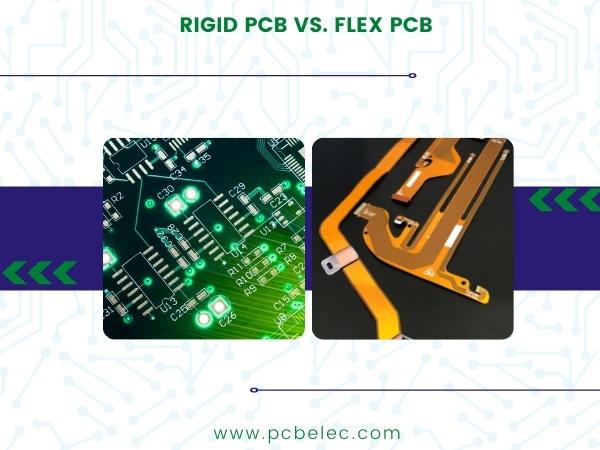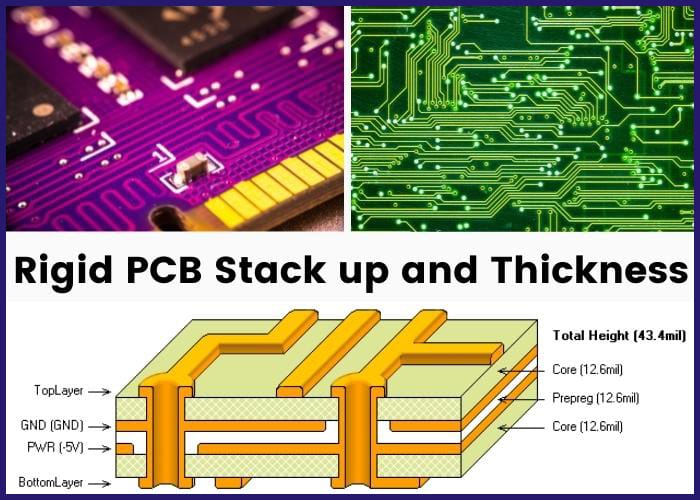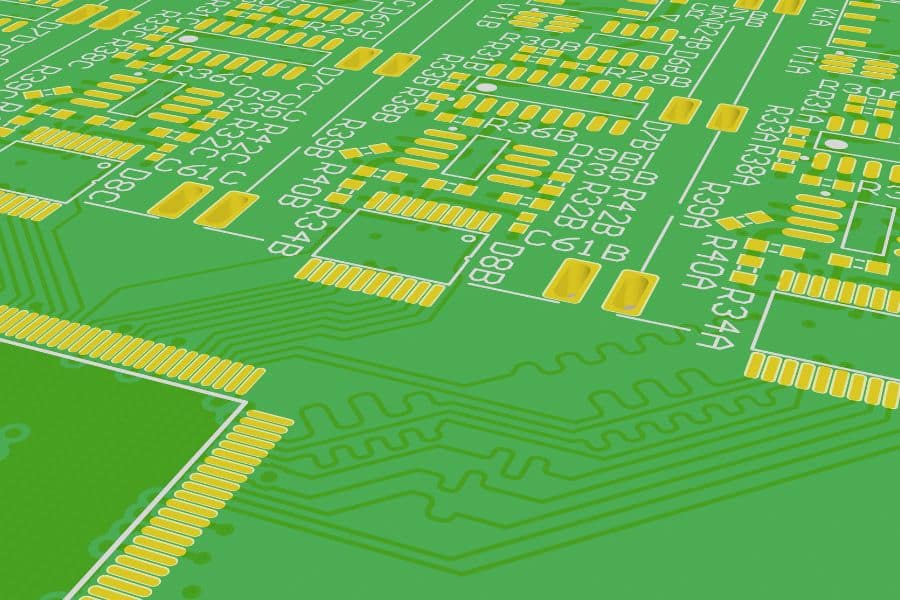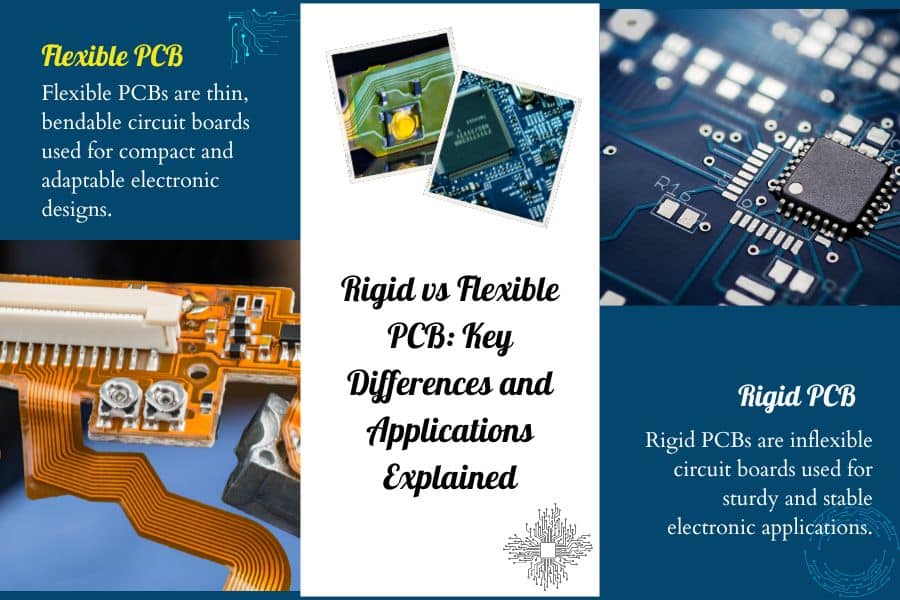PCBs (Printed Circuit Boards) use discrete wiring to connect electrical components and create a functional and complete device. A simple rigid PCB can consist of a couple of layers or sheets of copper integrated circuits, but rigid PCBs are most likely to possess many layers of circuits. The PCB designer requires these layers of copper circuitry in “routing” every circuitry that exists between the various components – where several layers of circuits may not be enough to complete the circuitry design and make all the required connections.

While all Printed Circuit Boards serve similar basic functions as the substrate used for electronics components, the materials used in constructing and designing these PCBs are what makes them different. PCBs are designed for specific and suitable applications. There are three classifications of PCBs namely Rigid PCB, Flex PCB, and Rigid-Flexible PCBs. This article provides a clear explanation of the fundamental difference between a Rigid PCB and a Flex PCB.
Key Differences Between Rigid and Flexible PCBs

The most prominent difference between a flex PCB and a Rigid PCB can be easily deduced from their respective names: A Rigid PCB is not flexible, whereas a flex PCB can be shaped or bent to fit into a given system. Flex circuits when correctly designed can be flexed also for several cycles repeatedly with no failure. The increased flexibility of flex PCBs comes typically at a greater cost, however, they are important for applications that required limited space, such as medical devices, consumer electronics, automotive and space applications
Rigid PCBs are common, especially as a result of their lower cost relative to flex PCBs. In traditional electronics like consumer electronics with a greater availability of space, manufacturers can be economical by making use of Rigid PCBs. However, flex PCBs are starting to take a larger part of the market share from non-flexible or rigid PCBs as a result of their adaptability and among several advantages like:
- Flexibility: Flex PCBs can be easily twisted, bent, and even folded to fit into the end or finished application. This gives the manufacturer the flexibility of having the circuitry fitted into the end device, instead of the endpoint device being designed around the circuitry. For instance, flex circuits are perfect for wearable devices, foldable mobile phones, and cameras. Rigid PCBs are hard and don’t offer such flexibility required in flex circuits applications.
- Connectivity: Flex circuits allow a better connectivity between various electronic components, circuit boards, and user interfaces in the packaging of electronics. Flex PCBs can also create connectivity in applications (dynamic flexible applications) where the flex circuit is required to flex continually over the device’s life cycle. These types of flex circuits are widely used in laptops PCs, display connectivity, and foldable electronics.
- Minimal Weight: Circuit boards with minimal weight produce an end product that is lighter. In present-day electronics market, this is essential because small, light-weighted devices are preferable to heavier electronic devices by electronics designers and consumers. This feature makes flex circuits to be perfect for drones and unmanned vehicles.
- Durability: Although rigid Printed circuit boards are generally stronger and thicker, flex printed circuit boards absorb vibrations and shocks better and effectively compared to rigid printed circuit boards. This makes flex PCBs more reliable with a long-term shelf life and functionality. And are extensively used in missile guidance systems, satellites, weapons, medical electronics, and various applications that require great environmental viability.
- Heat Resistant: Rigid printed circuit boards are likely to be damaged from heat, radiation, or chemicals; however, flex printed circuit boards are more resistant to heat and other damaging environmental conditions. This is the reason why flex PCBs are currently and widely used in automotive electronics.
- Manufacturing Process: Flex PCBs have flex circuit overlay and are manufactured using a process known as cover lay to protect the flex PCBs circuitry (from external or apparent damage)rather than using a solder mask. Flex PCBs are generally made using Polyimide. The sheet of Polyimide has covered heat adhesives for total protection. The adhesives fill every gap on the PCB which produces a smooth flow.
- Strength of Material: The thickness and strength of rigid printed circuit boards are typically glass. This makes rigid PCBs to be reinforced. Flex PCBs don’t provide a similar level of material strength, but instead make use of a base material (e.g. Polyimide) that is more flexible.
- Protection: Flex PCB uses circuit overlay for protection, while rigid PCB uses smolder mask for protection.
Related Reading


Similarities Between Rigid and Flexible PCBs
Rigid PCBs are not completely different from flex PCBs. There are certain similarities between both PCBs as well. A major similarity between flex PCBs and rigid PCBs is the two PCBs perform similar functions. In addition, both PCBs are built in similar ways; nevertheless, flex PCBs make use of flexible circuit coverlay for protection, while rigid PCBs use solder masks for protection.
The manufacturing and designing of rigid PCBs slightly differ from flex PCBs. As a PCB designer or manufacturer, you must be careful when designing either PCB and ensure you follow the requisite design rules. These include minimum space, trace width, minimum hole size, design thickness, and several other factors.
A device can be designed with both PCBs In it. A laptop PC is a common device with both rigid and flex PCBs. Some parts of the laptop require rigid PCB for its functionality while the other parts require flex PCBs for the smooth and correct transfer of information.

Real-World Applications of Rigid and Flexible PCBs
Both rigid and flexible PCBs find extensive use across diverse industries, catering to specific requirements. Here are some common real-world applications:
Rigid PCB Applications:
- Consumer Electronics: Desktops, laptops, televisions, and gaming consoles leverage rigid PCBs for their sturdy structure and easy component mounting.
- Industrial Equipment: Rigid PCB boards are ideal for machinery, robotics, and control systems that demand high mechanical strength.
- Networking Devices: Routers, modems, and switches rely on rigid PCBs for their complex circuitry and thermal management needs.
Flexible PCB Applications:
- Wearable Technology: Smartwatches, fitness trackers, and health monitoring devices utilize flexible circuits to conform to ergonomic shapes.
- Automotive Electronics: Flex PCBs enable complex cable routing in vehicles for infotainment systems, safety features, and under-the-hood components.
- Medical Devices: The flexibility of these circuits allows integration into compact medical equipment like hearing aids, pacemakers, and surgical tools.
- Aerospace & Defense: Missiles, aircraft controls, and satellites leverage flex PCBs for their light weight, durability, and resistance to vibrations.

How to Choose Between Rigid and Flexible PCBs
Rigid and flexible PCBs find applications across diverse industries, with each type offering unique advantages tailored to specific product requirements. When deciding between rigid or flexible circuits, consider the following factors:
- Product Size and Form Factor: Rigid PCBs are suitable for larger devices with ample internal space, such as desktop computers and TVs. Flexible PCBs excel in compact, space-constrained products like wearables, smartphones, and IoT devices.
- Durability and Environmental Conditions: If your application involves frequent vibrations, shock, or extreme temperatures, flexible PCBs with their ability to absorb impacts and resist heat make an ideal choice. Rigid boards are better suited for controlled indoor environments.
- Cost and Production Volume: While rigid PCBs are generally more cost-effective for high-volume production, flexible circuits may be more economical for low-volume or prototype runs due to their simplified manufacturing process.
- Connector Requirements: Rigid PCBs allow for robust connectors and ease of component mounting. Flexible circuits necessitate specialized connectors and assembly techniques for reliable interconnects.
- Design Complexity: For intricate, high-density layouts with complex routing needs, HDI technology combined with rigid-flex PCBs can provide an optimal solution.
At JHYPCB, we offer a comprehensive range of PCB solutions, including rigid, flexible, and rigid-flex PCBs, catering to diverse industry needs. Our team of experts can guide you through the selection process to ensure your product requirements are met efficiently.
Explore our PCB capabilities and get a quote tailored to your project needs.
Frequently Asked Questions About Rigid and Flex PCBs
Rigid PCBs typically use glass-reinforced epoxy laminate as the core material, with copper layers for circuitry. Other materials like aluminum or ceramics can also be used depending on application requirements.
Flexible PCBs can have up to 8 layers, though most applications use 1-4 layers. The number of layers depends on design complexity and routing needs.
Yes, flexible PCBs generally cost more than rigid PCB boards due to the specialized materials and manufacturing processes involved.
Absolutely. Many products leverage rigid-flex PCB technology which combines rigid and flexible substrates in a single PCB to meet design requirements.
HDI PCBs are used in compact electronics like smartphones, tablets, laptops where complex functionality needs to be packed into a small footprint.
Rigid PCB boards typically have better thermal performance due to their thicker copper layers and ability to integrate heat sinks. Flex PCBs require special thermal management techniques.
A flexible printed circuit board (flex PCB) is made of flexible polymer materials that allow it to be bent, twisted, or folded into various shapes without compromising functionality. Flex PCBs provide versatility in compact electronics.
A rigid PCB is the conventional type of printed circuit board made of inflexible materials like fiberglass-reinforced epoxy resin. Rigid PCB boards provide structural rigidity but cannot be bent or folded.
A rigid-flex PCB combines rigid and flexible circuit board materials into one integrated design. The rigid portions provide stiffness, while the flexible layers allow dynamic bending for complex routing.
FPC refers to fully flexible circuit boards made entirely of polymer substrates. Rigid-flex PCBs incorporate both rigid and flexible layers into a single stackup.
FR4 is a rigid, fiberglass-reinforced epoxy laminate material used for rigid PCBs. Flex PCBs use flexible polymer films like polyimide or polyester as the substrate material.
Key advantages of flex PCBs include compact packaging, lighter weight, improved reliability against vibrations/shocks, and the ability to fit into tight spaces with 3D routing.
Flexible PCBs are typically made using polyimide or polyester substrates with copper circuitry layers and a protective coverlay film.
FR4 is a rigid laminate material, while polyimide is a flexible polymer film. Polyimide offers better heat resistance and dimensional stability suitable for flex PCB fabrication.
FR4 is a fiberglass-reinforced epoxy material, while PTFE (Polytetrafluoroethylene) is a fluoropolymer material offering excellent dielectric properties and chemical resistance, though more expensive than FR4.
Conclusion
The PCB market which consists of two main types of PCBs namely rigid PCB and flex PCB is estimated to reach about $81 billion in 2024. The differences in both PCBs have wide applications in mobile phones, consumer electronics, wearable devices, space and automotive applications, missile guided systems, weapons, toys, and others. An understanding of the differences in rigid and flex PCBs is of great significance to designers and manufacturers in the PCB industry.
Rigid and flex PCBs have their respective applications and benefits. Flex PCBs design might be quite complex than rigid PCB designs, however, when strength and connectivity are required rigid PCBs are of greater importance. Newly produced bendable mobile phones and smart technology makes use of flex PCBs.
Recommended Reading
- What is the difference between SMT and SMD?
- What is the difference between wave soldering and reflow soldering?
- What is the difference between Single-Sided PCB and Double-Sided PCB?
- What is the defference between PCB and PCBA?
- The Difference Between Gold Plating and Immersion Gold
- What Are The Advantages And Applications Of Rigid-Flex PCBs?
- What is a PCB Manufacturer? The Definitive Guide
- Custom Flex PCB:Tailored Solutions for Your Applications
- Custom PCB Fabrication in China – Prototyping & Mass Production
- Expedited PCB Services – Quick Turnaround for Your Urgent Needs
- Rapid PCB Prototyping and Production – The Keys to Accelerating Your Product Launch
- Shenzhen – The Global Hub for High-Quality PCB Assembly Manufacturing
- Evaluating and Selecting Quick-Turn PCB Assembly Manufacturers in China












